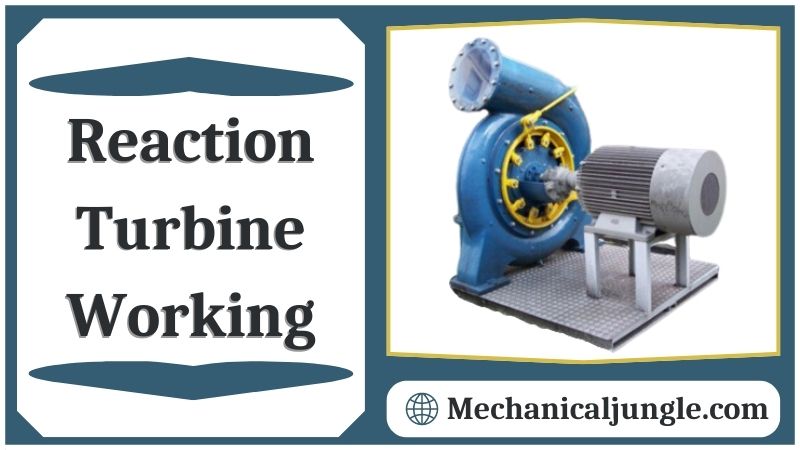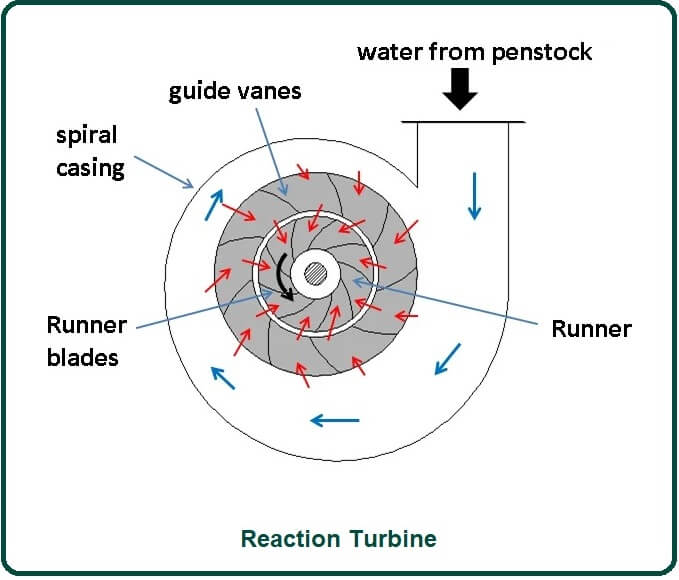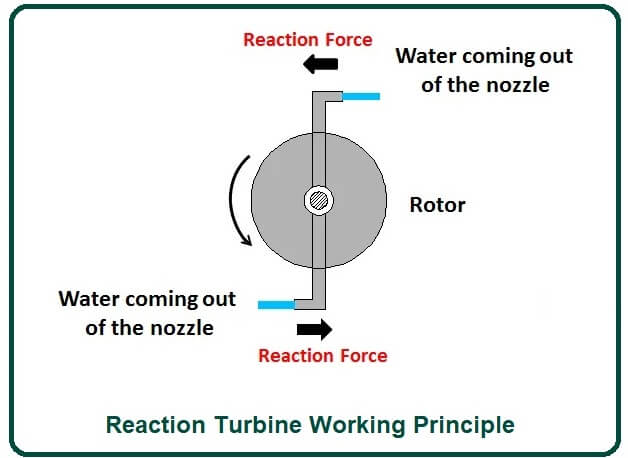Important Point
What Is Reaction Turbine?
They have vast applications and can be classified in various ways. According to the water flowing through turbine runners, turbines are classified into two categories, i.e., impulse turbines and reaction turbines. Pelton wheel turbines are the type of Impulse turbine, but here we only talk about reaction turbines. A reaction turbine is different from an impulse turbine in many ways.
In response, the pressure of the turbine is not the same throughout the turbine. When the water enters the turbine runner, a part of the available energy of water is converted into kinetic energy, and the remaining part is converted into pressure energy. Pressure varies throughout the turbine. At the entrance of the turbine, the pressure is much higher than the pressure at the exit.
When the water starts flowing through the runner, the pressure energy starts converting into kinetic energy. The turbine cover must be airtight and always filled with water due to pressure differences. The pressure at the entrance is equal to the atmospheric pressure, but the runner pressure begins to decrease and decreases below atmospheric pressure.
This difference in pressure is the reason for the fluid to flow, i.e., the fluid flow from the high-pressure area to a low-pressure area. The difference between runner pressure is known as reaction pressure, and this type of turbine is known as reaction turbine.
Francis, propeller, and Kaplan are some commonly used reaction turbines. In this article, we will examine the components of reaction turbines & reaction turbines in depth. We will also discuss the reaction turbine working principle.
Also, Read: What Is an Engine? | Types of Engine | Parts of Engine
Reaction Turbine:
Reaction turbines are the type of turbine that develops torque by reacting to the pressure or mass of a gas or fluid. The operation of reaction turbines is described by Newton’s third law of motion, and the response is the same and opposite. The water pressure head, while flowing over the van, changes to the velocity head and eventually reduces to atmospheric pressure before leaving the wheel.
In a reaction turbine, water enters the wheel under pressure and flows over the van; as the water flows over the van, under pressure, so the wheel of the turbine runs full and may be submerged under the tailrace, or Discharge may occur in the environment.
Also, Read: What Is Automobile? | Type of Automobiles
Working of Reaction Turbine:
Waters are supplied by penstock from the reservoir to a turbine and then enter the casing. The cover completely surrounds the runner. This casing distributes the water in the turbine runner according to the perimeter. This cover is always filled with water. Inside the casing number of the existing fixed vanes, it partially transforms the available head with water into a dynamic head.
The cross-sectional area of the casings is gradually reduced to maintain a constant velocity of water throughout the turbine runner. These various components and veins help the water flow into the runner with minimal loss of energy.
When water enters the runner above the rotor, it has both kinetic energy and pressure energy. When water collides with the moving van / rotating van, it applies the impulse force due to the kinetic energy, as in the case of the Pelton wheel.
As the water flows over the moving / rotating vane, it creates a pressure difference on the vane due to the airfoil shape of the vane, which causes the water to apply a lift force over the vane. These lift forces are also known as the reaction force.
The impulse and reaction force will rotate the runner. For these reasons, it is sometimes called an impulse response turbine. After the runner, the water flows out through the draft tube, which is placed under the runner. If you have any questions related to thises article, then comment.
If you liked thises article, do not forget to share it on social networks. The draft tube provides the suction head at the runner exit. The exhaust water goes into the tailrace, which further utilizes in various applications. All this is the basics of reaction turbines. All reaction turbines operate on the same principle.
Also, Read: What Is Centrifugal Pump? | Centrifugal Pump Working Principle | Working of Centrifugal Pump
Parts of Reaction Turbine:
The reaction turbine Parts are given below in detail.
#1. Guide Mechanism
This reaction is connected to the turbine component spiral casing. The most important function is to ensure that the direction of the water hitting the impeller blade is along the axis of the turbine. Otherwise, the water will create a strong vortex as it passes through the spiral layer.
Its rotating impeller blade is ineffective. With modern turbines, the angles of these guide vans can be adjusted. Waters flow can be adjusted by changing the angle of these guide vanes according to the turbine load. The guide vanes are fixed between two rings in the form of wheels.
These wheels are fixed in a spiral cover. The guide van is designed properly to: allow water to enter the runner without jerking. Allow the water to flows over them without creating eddies. Allow the required amount of water to enter the turbine.
This is done by adjustings the opening of the van. All guide vans can rotate about their respective pivots, which are connected to the regulating ring by some mechanical means. The regulating rings are connected to the regulating shaft through two regulating rods.
The guide vanes can be closed or opened by rotating the regulating shaft; thus, the required amount of water flows as required. The regulating shaft is driven through a governor, whose function is to control the turbine, i.e., to keep the speed constant at different loads. Guide vanes are usually made of cast steel.
#2. Turbine Runner
A reaction turbine’s runner consists of runner blades fixed to the shaft or ring, depending on the type of turbine. The blade is designed properly, so that water can enter and leave the runner without any shock. The surface of the runners is made very smooth.
The runners can be cast in one piece. It can be made of separate steel plates and welded together. For a lower head, the runner can be cast with iron. But for high heads, the runners are made of steel or alloys. When water is chemically impure, the runner is made of a special alloy.
The runner is closed to a shaft, which can be vertical or horizontal. If the shaft is vertical, it is called a vertical turbine. Similarly, if the shaft is horizontal, it is called a horizontal turbine.
#3. Spiral Casing
A curved housing with a corresponding decrease in cross-sectional area along the perimeter. Due to the small cross-sectional area, there is an opening through which water can flow into the blade from the start of the casing.
Pressure falls with the casing, resulting in the same velocity of water hitting the rotor paddle. Therefore, the cross-sectional area in a circumferential direction is reduced to make the pressure uniform, and the moment and speed of the impact blade become uniform.
Water from a pipeline is distributed in a casing around the ring of the guide. These casings are designed in such a way that their cross-sectional area decreases uniformly around the perimeter. As a result, the casing will be either a spiral casing or a scroll casing.
#4. Draft Tube
A draft tube connects the runner’s exit to the trail run. As the water released from the blade is a relatively low pressure, its cross-sectional area increases along its length. The water, after passing through the runners, flows downstream through a tube called a draft tube.
This, generally, sinks about 1 m below the tailrace level. Its cross-sectionals are continued to expand, which helps relieve pressure as it flows toward the tailrace.
A draft tube has the following functions. This raises the top of the water by an amount equal to the height of the runner outlet above the tailrace; This increases the efficiency of the turbine.
Reaction Turbine Working Principle:
The working of reaction turbines can be well understood by the rotor having a moving nozzle and the high-pressure water coming out of the nozzle. As soon as the water comes out of the nozzle, a reaction force is experienced by the nozzle. This reaction force rotates the rotor at a very high speed. Similarly, in the working of a reaction turbine, the reaction force is generated by the moving fluid above the impeller blade.
The reaction forces generated in the impeller blade cause the impellers to rotate. After driving on the impeller blade, the liquid ends up in the groove and finally in the trail race. Using a rotor with a moving nozzle and high-pressure water coming out of the nozzle will help us understands the working principle of the reaction turbine in a good way. The nozzle receives a reaction force when water comes out of the nozzle.
This reaction force causes the rotor to rotate at high speed. In reaction turbines, in the same way, a reaction force is produced by the movement of fluid on the runner blades. The reaction force generated on the runner blade rotates the runner. After the runner blade goes over, the fluid enters the draft tube and finally enters the trail race.
Also, Read: What Is a CNC Machine? | CNC Block Diagram | Parts of CNC Machine
Advantages of Reaction Turbine:
Here, the different advantages of reaction turbines are as follows.
- It has high hydraulic efficiency.
- This requires less space.
- The reaction turbines use oil-free exhaust systems.
- It has a small size.
- It has a high capacity to use high temperatures and high pressure.
- This type of turbine has a high working speed.
- It is easy to construct.
- The blade has a higher efficiency than an impulse turbine.
Disadvantages of Reaction Turbine:
Here, the different disadvantages of reaction turbines are as follows.
- This type of turbine generates thrust force.
- It confronts the problem of the cavity.
- It does not have symmetrical blades.
- These turbines require higher maintenance than impulse turbines.
- Higher maintenance costs are required.
Applications of Reaction Turbine:
Here, the different applications of reaction turbines are as follows.
- Apart from cross-flow turbines, this is the only turbine to achieve optimum power output at low peak water head and high velocity, which is not efficient.
- Reaction turbines are used in wind power mills to generate electricity.
- It is the most widely used turbine for generating electricity in hydroelectric plants.
Frequently Asked Questions (FAQ)
What Is Reaction Turbine?
Reaction turbines are turbines that use the pressure as well as the velocity of the moving water to rotate. Reaction turbines are placed in the water stream where the water enters the casing tangentially. After rotating the blades, the water axially leaves the casing of the turbine.
Reaction Turbine
Reaction turbines are turbines that use the pressure as well as the velocity of the moving water to rotate. Reaction turbines are placed in the water stream where the water enters the casing tangentially.
Impulse Turbine and Reaction Turbine
Impulse turbines are most efficient for use in cases where the flow is low, and the inlet pressure is high. Reaction turbines develop torque by reacting to the gas or fluid’s pressure or mass. The pressure of the gas or fluid changes as it passes through the turbine rotor blades.
Reaction Turbine Working Principle
A reaction turbine is constructed of rows of fixed blades and rows of moving blades. The fixed blades act as nozzles. The moving blades move as a result of the impulse of steam received (caused by a change in momentum) and also as a result of the expansion and acceleration of the steam relative to them.
Parts of the Reaction Turbine
- Guide Mechanism
- Turbine Runner
- Spiral Casing
- Draft Tube
Like this post? Share it with your friends!
Suggested Read –
- Cnc Definition
- Boiler Mountings
- Parts of a Cnc Machine
- Domestic Electrolux Refrigerator | Different Components of Domestic Electrolux Refrigerator
- Types of Angle Plates | Box Angle Plate of Angle Plate | Swivel Angle Plates of Angle Plate | Cast Iron T-Slotted Angle Plate of Angle Plate
- What Is Wilson-Hartnell Governor? | Wilson Hartnell Governor | Construction of Wilson Hartnell Governor | Working of Wilson Hartnell Governor
- Cochran Boiler | Cochran Boiler Working | Working Principle of Cochran Boiler | Applications of Cochran Boiler | Advantages & Disadvantages of Cochran Boiler
- What Is Cupola Furnace? | Cupola Furnace Design । Cupola Construction | Purpose of Cupola | Working Principle of Cupola Furnace: | Advantages of Cupola Furnace | Disadvantages of Cupola Furnace | Applications of Cupola Furnace


